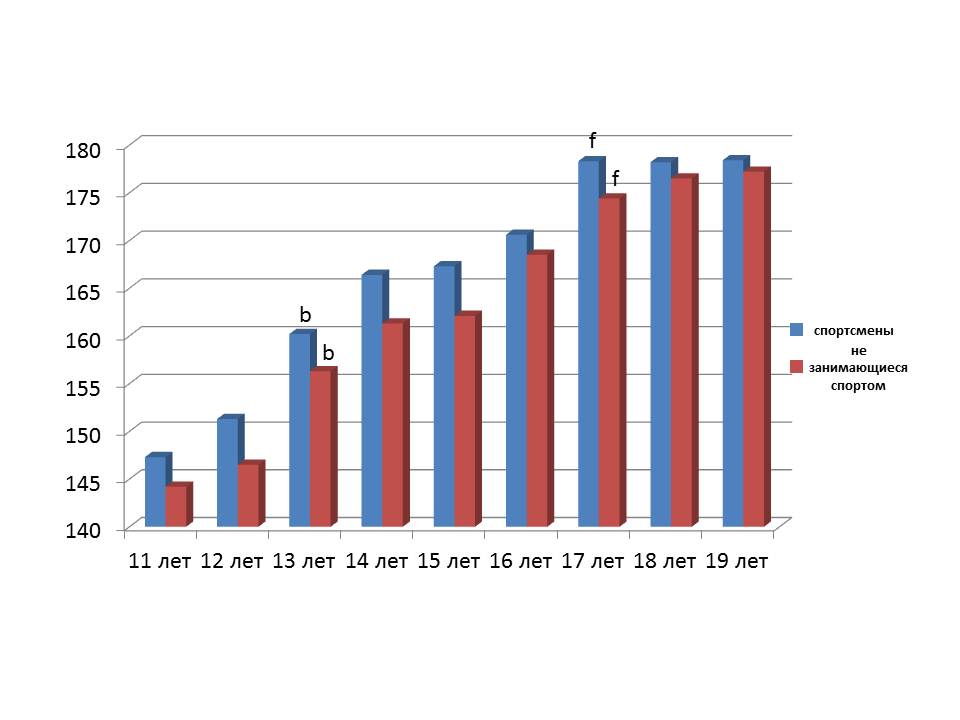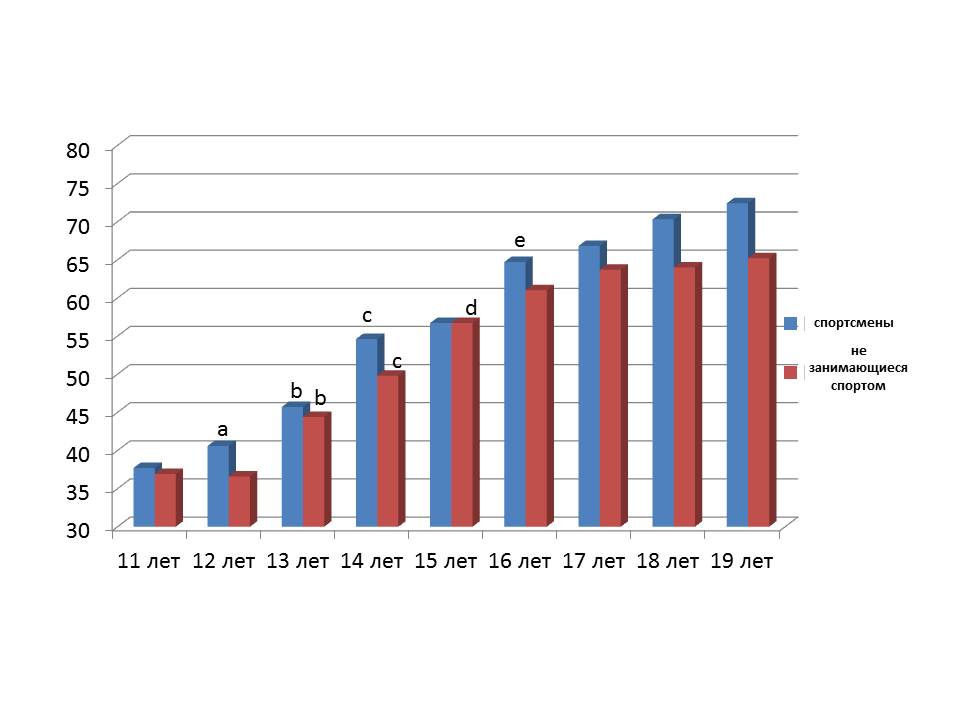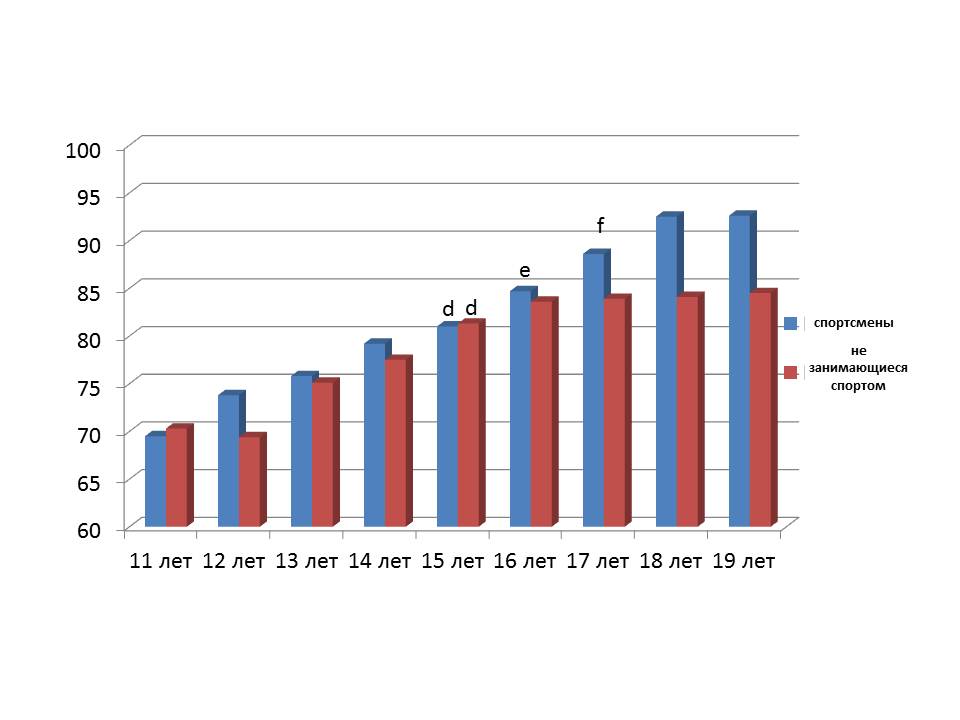Abstract
The study involved athletes (n = 74) and non-athletes (n = 45). The features of physical development in athletes and non-athletes were revealed. The adaptive behavior of athletes as a result of the influence of physical activity was determined. It was found that physical activity acts as a growth stimulator only at the initial stage of training, leading to the accelerated development of the body length of athletes (P <0.01)]. The body mass of the studied groups of athletes by the age of 12 years is ahead of their peers who are not involved in sports. However, by the age of 13 this advantage is leveled. The dynamics of body weight is characterized by a gradual and stable increase in the studied indicator in both athletes and non-athletes. This indicates the stability of the vector of the development of body mass of boys in the ascending branch of ontogenesis from 11 to 14 years. A comparative analysis of the rate of development of body weight in those involved and not involved in sports allows identifying the intensity of growth and duration of increase in body weight as a variable factor in physical development under the influence of physical exercises. The most intense increase in chest circumference was found in athletes aged from 11 to 12 years (P <0.001), then this advantage is lost and restored to 17 years, and is stable until the end of the studied age segment up to 19 years.
Keywords: Physical developmenthealthathletestudent
Introduction
The most important indicator of students' health is physical development, which is understood as a complex of morphological, functional and somatoscopic properties of a body, characterizing quantitative and qualitative processes.
The anthropometric studies are conducted in accordance with the level of physical development of students conduct. Physical development is one of the main indicators of health and can change under the influence of various diseases and environmental factors.
The state of health and physical development are closely related, therefore, during a medical examination of students, they should be examined in parallel. The harmonious development can be judged by the comparison of the indicators of length and body weight.
As it is known, the following factors affect human health: the environment (geography, climate, ecology) – 20 %, the healthcare system (lack of constant medical supervision, low primary prevention, poor medical care) – 10 %, genetics – 20 %, lifestyle (daily regimen, personal hygiene, quenching of body, nutrition, physical activity) – 50 % (Yarullin, 2000).
Physical activity is included in the number of the main factors determining the level of metabolic processes of a body and the state of bones, muscle and cardiovascular systems. It is associated with the main aspects of health – mental, physical and social, throughout whole life. At school age, in traditional classes, physical education is carried out according to the traditional program (2 hours a week), and in the conditions of an expanded physical regime, training sessions were held daily, forming physical activity in sports sections.
Somatic development is a complex, multiphase process that reflects the transition of quantitative changes into qualitative ones when a body moves to a fundamentally new level of functioning (Godina, 2001, etc.). At the same time, the degree of physical fitness and the degree of biological reliability change. Somatic development in its essence is aimed at the increase in the functional capabilities of body and is an integral component of adaptation. Both delayed and extremely accelerated somatic development negatively affect, first of all, the nature of adaptation, the working abilities of an organism and its physical performance (Melesha, 2008; Pseunok & Mugotlev, 2014; Shakhanova & Silantiev, 2007; etc.).
Similar results are presented in international scientific literature (Stinson, Bogin, Huss-Ashmore, & O'Rurke, 2000; Vershubsky & Kozlov, 2001, etc.).
Problem Statement
A human body is exposed to many external influences during training, the key of which is physical activity. In connection with the adaptation to them a body undergoes the restructuring in accordance with the needs of sports activities. Any functional system works in order to meet current needs, as a result of which there is the maintenance, preservation of homeostasis and high performance in new conditions. Sport is a convenient model for the study of the physiological mechanisms of a body and identifying sensitive periods.
In this regard, the study the physical development and functional state of the body of athletes and non-athletes is of interest, because they are of fragmented nature and tied to the effects of specific sports. This study will reveal the features of adaptive mechanisms, physical fitness, and level of health.
In a longitudinal mode such type of the study will allow assessing the functional state and physical development of the body of athletes and non-athletes at different periods of ontogenesis. In this regard, the need for research on adaptive mechanisms, physical fitness and level of health becomes apparent.
These aspects formed the purpose of the presented research.
Research Questions
The research question is presented by the need to study of anthropometric indicators of children and adolescents, depending on the level of motor activity.
Purpose of the Study
The purpose of the study is to assess physical development of athletes and non-athletes depending on the level of physical activity
Research Methods
During the course of the anthropometric studies the authors provided the necessary methodological impeccability and thoroughness in the collection and processing of anthropometric material, the use of standardized methods, which makes the results of individual observations obtained by different authors comparable among themselves and makes it possible to use widely the obtained data. The study was conducted with the participation of both athletes (n = 74) and non-athlete boys (n = 45).
The physical development of students was evaluated by the main indicators of anthropometric measurements. The measurements of children were performed using standard tools in compliance with a unified methodology (Andrukhaev & Agirov, 2012). The results of the study were processed by the method of variation statistics with the calculation of the criterion of reliability (t) by Student and the level of probability (P).
Findings
The results of the study allow assessing the dynamics and nature of the physical development of athletes and their peers who are not involved in sports.
Body length is one of the main indicators of ongoing growth processes. The changes are characterized by a gradual and unidirectional increase in growth in both athletes (n = 74) and boys who are not involved in sports (n = 45). At the age of 11 years, the indicator is 144.2 ± 7.3 for boys who are not involved in sports. In peers involved in sports, the body length is 145.3 ± 9.4, which does not significantly differ from the indicator of the compared group (P> 0.05) (Figure
During the studied period of ontogenesis, the indicator among athletes reached 178.4 ± 11.6, which also did not differ from the indicator of a comparable group of peers (177.2 ± 7.6; P> 0.05). At the same time, it is noted that a sharp increase in the scatter, demonstrating the heterogeneity of the trait among individuals in the group of athletes, occurs earlier and continues throughout the entire observed period (ranges from 9.2 to 13.8 cm), while in individuals who are not engaged in sports, such a phenomenon is observed only between 13 and 16 years. Probably, the reasons for this are the overlapping processes of sports selection and the active impact of specific means of sports exercises.

The differences between the closest age groups were significant in both studied groups between 12 and 13 years old (P <0.001) and between 16–17 years old (P <0.05). The comparison of the data of athletes and non-athletes suggests that physical activity acts as a growth stimulator only at the initial stage of training, leading to an accelerated development of the body length of athletes (P <0.01). Later, the rate of development of the indicator is equalized and no significant differences between the studied groups are found.
The changes that occur with body weight in ontogenesis to a greater extent than body length depend on environmental influences, in particular on the effects of sports exercises performed systematically. The dynamics of body weight was characterized by a gradual and stable increase in the studied indicator both in athletes and boys not involved in sports. According to this it is possible to conclude that the vector of the development of body mass of boys from 11 to 14 years is stable (Figure

The differences between adjacent age groups are significant in non-sportsmen aged from 12 to 15 years. In this case, the maximum growth falls to 12–13 years (P <0.001), and in 13–14 and 14–15 years, the rate of development of the mass decreases (P <0.05).
The onset of significant mass growth of young athletes occurs already at 11–12 years old (P <0.05), the development rate is reproduced at 12–13 years old (P <0.05). It is likely that the switching processes of the external environmental impact lead to the fact that the rate of development of the mass increases between 13–14 years (P <0.01), and then after a one-year period a significant increase occurs again. The comparative analysis of the rate of development of body weight of boys involved and not involved in sports allows identifying the intensity of growth and duration of the increase in body weight as a variable factor in physical development under the influence of physical exercises. The comparison of the development results of the body mass of the studied groups allows stating that by the age of 12, athletes are ahead of their peers who are not involved in sports. However, by the age of 13 this advantage is leveled. As a result of constant, albeit unreliable, annual increases in body weight, a group of athletes of 18 years is ahead of another group. Moreover, later, the gap between the indices of the groups does not decrease, but increases (P <0.01).
The boys of the studied groups steadily manifest the vector of positive development of the chest circumference up to 16 years (Figure

The group of children who are not involved in sports is characterized by the increase in the indicator by 8.3 % (Figure
The most distinct influence of sports is manifested in the circumference of the chest, which suggests that it is less dependent on genetic inclinations than body length and weight. An intensive increase in the circumference of the chest occurs in the process of playing sports at the age of 11–12 (P <0.001). Over this year, the indicator increases by 5.8 %.
The next leap of the studied indicator occurs in a year, that is, in 13–14 years and in another year – in 15–16 years (P> 0.05). This is followed by a two-year period, where the annual growth is reliable at (P> 0.01). As a result of such changes in athletes over the studied period of ontogenesis, the chest circumference increases from 69.5 ± 5.2 (11 years old) to 92.6 ± 8.7 cm (19 years old), which is 24.9 %.
The comparative analysis of the chest circumference of non-athletes and their peers-athletes suggests that athletes are ahead in the development of this total body size after a year of training, then this advantage is lost and restored by the age of 17 years, but now it is stable until the end of the studied age period, that is, up to 19 years.
Conclusion
The conducted studies present the methodological basis for the solution of the problem of improving the adaptation of children and adolescents to various environmental factors in preserving and strengthening health, preventing and correcting their physical regime.
The practical significance is in the possibility of using recommendations for the optimization of the daily routine in the life of schoolchildren with physical activity deficits.
Conclusions:
The obtained results suggest that physical activity acts as a growth stimulator only at the initial stage of training, leading to an accelerated development of the body length of athletes (P <0.01). Later, the growth rates of growth indicators are leveled and no significant differences between the studied groups are found.
The comparison of the development results of the body mass of the studied groups allows stating that by the age of 12, athletes are ahead of their peers who are not involved in sports. However, by the age of 13, this advantage is leveled. As a result of constant, albeit unreliable, annual increases in body weight, a group of athletes of 18 years is ahead of another group. Moreover, later, the gap between the indicators of the groups does not decrease, but increases (P <0.01)
The comparative analysis of the chest circumference of non-sportsmen and their peers-athletes suggests that athletes outgrow after a year of training, then this advantage is lost and restored by 17 years, but now it is stable until the end of the studied age period, that is, up to 19 years.
References
- Andrukhaev, H. M., & Agirov, A. K. (2012). Regulatory and assessment tables of physical development of children of preschool and school age of the Republic of Adygea. Maikop: ASU Publ. House.
- Godina, E. Z. (2001). The dynamics of the processes of growth and development in humans: spatio-temporal aspects (Doct. dissertation thesis). Moscow.
- Melesha, N. P. (2008). Morphological changes in adolescent students. Formation of physical culture and health culture of students in the context of modernization of education. Mater. of the All-Russ. Sci. and Pract. Conf. (pp. 151–153). (Elabuga, 12–13 November 2008).
- Pseunok, A. A., & Mugotlev, M. A. (2014). Age-related features of the regulation of heart rate in schoolchildren with different modes of motor activity. Monograph. Maykop: ASU Publ. House.
- Shakhanova, A. V., & Silantyev, M. N. (2007). Innovative educational technologies, physical activity, adaptation (pp. 81–83). Maykop: ASU Publ. House.
- Stinson, S., Bogin, B., Huss-Ashmore, R., & O'Rurke, D. (Eds.). (2000). Human Biology: An Evolutionary and Biocultural Perspective. New York; Wiley-Liss, Inc.
- Vershubsky, G., & Kozlov, A. (2001). Adaptive norm of newborn's body mass in ethnic minorities of northern Russia. Children and Young People in a Changing World: A Holistic Approach. Agrigento, Italy.
- Yarullin, R. K. (2000). The subject physical education "is the source of schoolchildren receiving education in physical education. Phys. Ed.: Ed., Train., 4, 911.
Copyright information

This work is licensed under a Creative Commons Attribution-NonCommercial-NoDerivatives 4.0 International License.
About this article
Publication Date
31 October 2020
Article Doi
eBook ISBN
978-1-80296-091-4
Publisher
European Publisher
Volume
92
Print ISBN (optional)
-
Edition Number
1st Edition
Pages
1-3929
Subjects
Sociolinguistics, linguistics, semantics, discourse analysis, translation, interpretation
Cite this article as:
Guchetl, A., Yanvarovna, C. A., Askerovna, P. A., Gissovna, K. M., Turkubievna, P. Z., Aslanovich, N. K., & Gasanova, R. A. (2020). Assessment Of Physical Development Indicators Of Students Depending On Physical Activity Level. In D. K. Bataev (Ed.), Social and Cultural Transformations in the Context of Modern Globalism» Dedicated to the 80th Anniversary of Turkayev Hassan Vakhitovich, vol 92. European Proceedings of Social and Behavioural Sciences (pp. 2919-2925). European Publisher. https://doi.org/10.15405/epsbs.2020.10.05.387

